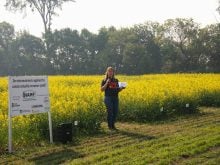Lower seeding rate | Wider row spacing requires weed management
LACOMBE, Alta. — An Alberta canola grower hopes to dramatically reduce seeding costs by using a precision planter more commonly used in row crop production.
Craig Shaw’s interest in the technology was prompted by his frustration over how difficult it was to accurately place canola with large broad acre seeding equipment.
He hopes that research plots on his farm and at Agriculture Canada’s research centre near Lacombe using a Monosem planter will help farmers learn about the possible benefits to using a precision planter to seed canola.
Read Also

Controversy fails to prevent PGR use in oats
Some Manitoba oat growers are still using chlormequat chloride — the active ingredient in Manipulator —and sometimes to measurable success.
“We wanted to know if we can do a better job of seeding, have less mortality and less input costs,” Shaw said during a field day at his farm.
“We said, ‘we needed to do a better job. How do we do it?’ ” he told farmers and researchers during the tour.
A planter was purchased and plots seeded using a grant from the Alberta Crop Industry Development Fund and money left over from Reduced Tillage Linkages, a research organization that had encouraged reduced tillage practices.
The precision planter can seed low rates, very precisely. Growers hope it will let them cut seeding rates by more than half.
Sixty foot test rows were seeded at 12- and 24-inch row spacings. The seed was placed 2.39, 1.87, 1.2 and .93 inches apart and at 2.5 and 3.2 pounds per acre.
“Under ideal conditions, low seed rate will give good yields,” said Shaw.
Typically a planter might be spaced at 15 inches, but the researchers wanted to know how wider row spacing would work.
“How wide do we go before we have a yield penalty?” he said.
Trash management was one of the problems encountered when using the seeder.
A residue manager was placed in front of the disc openers to sweep straw away from the rows.
Darren Feitsma of Ponoka, Alta., said he has cut his canola seeding rates in half since he began using a Case 1240 row planter to seed canola three years ago.
“Before, we didn’t know if it was canola volunteers or a crop. Now you can distinctly see what you’ve planted.”
He said over three years he has saved $250,000 of seed on 5,000 acres of canola by reducing seeding rates to two lb. per acre from five lb.
The planter has a 15-inch row spacing, and this year he seeded 230,000 seeds per acre, up from last year’s 200,000 seeds per acre.
His goal is to drop the seed required to 160,000 seeds per acre to reduce seeding costs.
The downside is increased weed management because of the wide row spacing, he added.
Feitsma said he had troubles with the vacuum meter disc plugging during the first two seasons but has since made modifications to stop it from happening.
He has also added a second pass in the spring for fertilizer, but still believes savings are substantial.
Martin Sherren of Lacombe attended the field day to take a closer look at the width of the row spacing in canola and what would be a reasonable distance between the rows.
“I wanted to see how far apart … is optimal and that you can reasonably go to see if there is a savings on the amount of seed,” said Sherren.
“This is a lot of work for them to go to. I have to be convinced there is a value and savings to go to this much work.”















